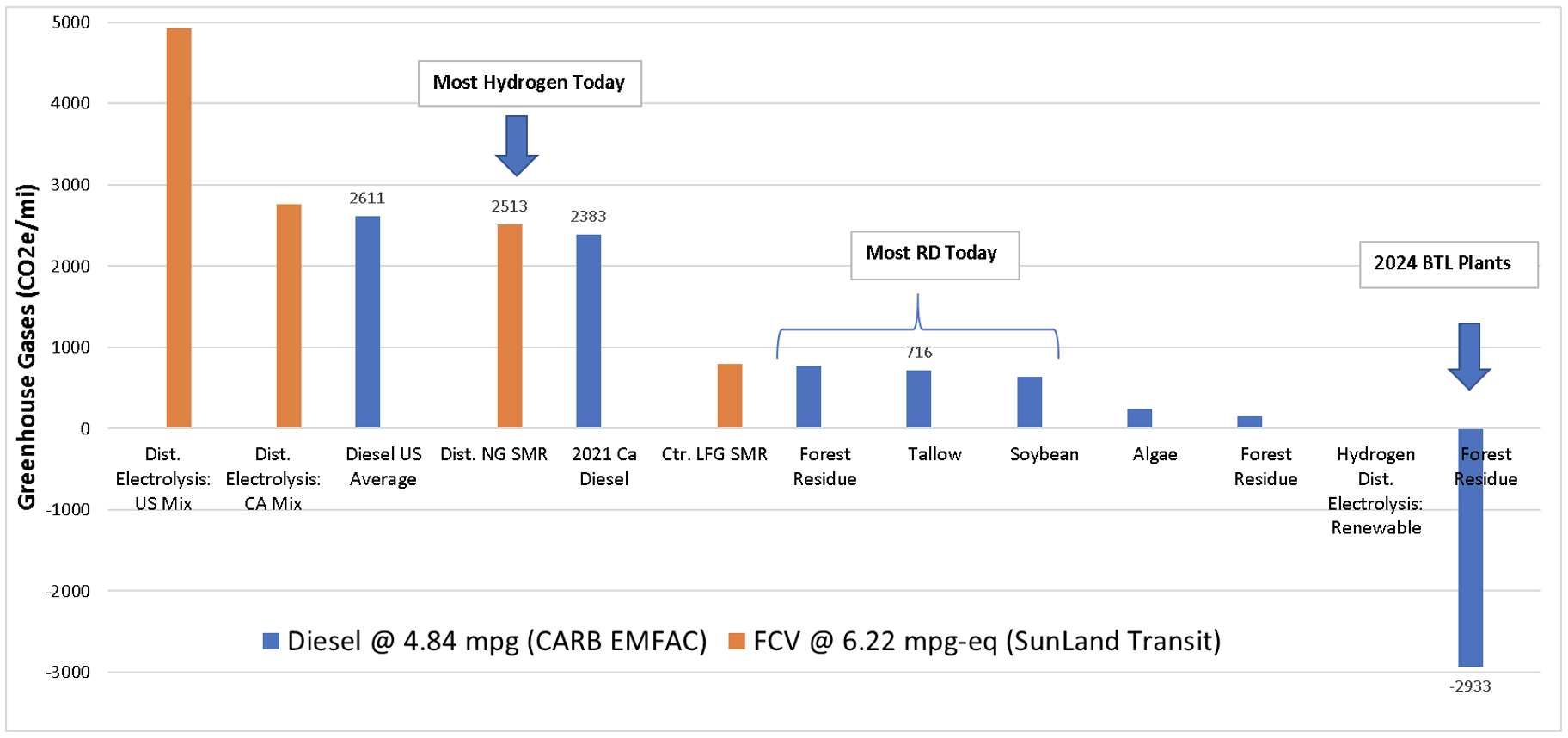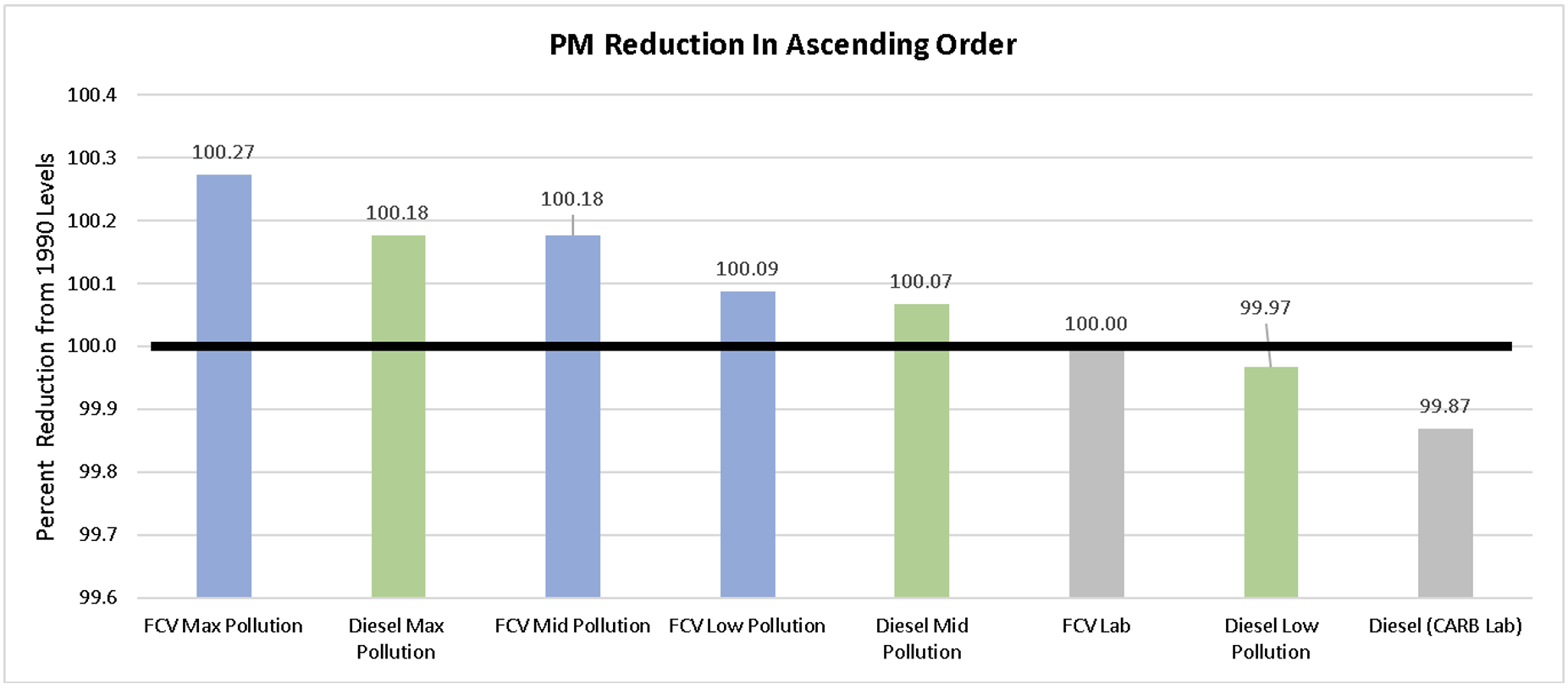How does Hydrogen compare to Biomass-Based Diesel on GHG, PM, and petroleum reduction?
Link to article: https://stillwaterassociates.com/how-does-hydrogen-compare-to-biomass-based-diesel-on-ghg-pm-and-petroleum-reduction/
March 4, 2021
By Gary Yowell
Over the last few years, the California state legislature has considered numerous bills which seek to incentivize the replacement of diesel fuel with hydrogen in the transportation sector. Such a transition would require significant investments in hydrogen retail infrastructure and hydrogen fuel cell vehicles (FCVs), and the legislature aims to soften that blow with policy. It seems to be working. Several vehicle manufacturers and start-up manufacturers are promoting heavy-duty (HD) FCV vehicles in response to these legislative incentives. Proponents of these measures cite FCVs’ public benefits in many forms, including greenhouse gas (GHG) emissions reductions, air quality improvement (in the form of particulate matter (PM) reduction), and petroleum displacement with low-CI alternatives. In today’s article, we take a look at how hydrogen used in FCVs stacks up against one of the fastest-growing low carbon intensity (low-CI) fuels in California today – biomass-based diesel, more specifically renewable diesel (RD) and biomass-to-liquid (BTL) fuels. There is also a comparison to be made on the NOx reduction (i.e. ozone) front, but that’s a topic for another day.
In the analysis that follows, we compare the emission reductions achieved by replacing a 1990 “Dirty Diesel” vehicle (used as a comparison point to be consistent with California’s GHG reduction goals from 1990 levels) with today’s much-improved “Clean Diesel” and “Super-Clean Diesel” vehicles when fueled with 100% RD or with a hydrogen FCV.[1] Table 1 below lists the key assumptions of this analysis.
Table 1. Key Assumptions

We also assume a carbon intensity (CI) of 102 gCO2e/MJ for 1990-vintage petroleum diesel, 32 gCO2e/MJ for renewable diesel, and 93.25 gCO2e/MJ for 2021 CARB diesel retail blend (which is 6.6% biodiesel 16.4% RD and 77% petroleum diesel).
In the sections that follow, we discuss the findings of our comparative analysis of hydrogen FCVs vs. RD-fueled diesel vehicles in the areas of GHG reduction, PM reduction, and petroleum displacement. Our analysis finds that HD FCVs compete poorly relative to low-cost biomass-based diesel options used in conventional diesel vehicles when it comes to these public benefits.
Greenhouse Gas Reduction
Figure 1, below, displays well-to-wheels (WTW) CO2 equivalent emission values.[5] This WTW assessment takes into account not only the CI of the fuel used but also the efficiency and emissions of the vehicle when run on that fuel. Diesel is shown as either petroleum, RD, or Biomass-to-Liquid.[6] As can be seen, FCVs have 4% lower GHG emissions than conventional petroleum diesel. However, thanks to the California LCFS program, which has increased the amount of RD and BD in the diesel pool, the current California retail diesel mix has, on average, 5% lower GHG emissions than FCVs using hydrogen made from the lowest-cost and most common method – distributed natural gas processed in a Steam Methane Reformer (shown as “Dist. NG SMR” in Figure 1 below). Because this hydrogen source has high CO2 emissions (as shown in Figure 1 below), California legislation requires hydrogen used for FCVs to have 33% renewable content. Zero-CI “green hydrogen” (shown as “Hydrogen Dist. Electrolysis: Renewable” in Figure 1 below) is not yet commercially available. Importantly, hydrogen’s electrolysis and compression are so energy-intensive that FCVs using this fuel consume 40-55% more energy than their diesel counterparts per mile driven. If green hydrogen were produced at 10 cents/kWh it would have nearly three times the fuel cost per mile as the diesel vehicle fueled with RD.
Figure 1. Heavy-Duty Vehicles Well-to-Wheel Greenhouse Gas Emissions with Various Feedstocks (2018)

Source: Results created by ANL on 10/16/2018 using GREET1_2018 version, October 2018 release
In the future, FCVs may match RD GHG emission reductions. Today, however, FCVs’ WTW GHG emissions are two to three times higher than RD.
A new diesel fuel akin to RD is Biomass-to-Liquid (BTL) diesel with even lower GHG emissions, at least three BTL plants are under construction/development with a combined capacity of 90 million gallons per year by 2024.[7] BTL fuel developers claim they will produce diesel with zero and negative carbon intensity values -120 to -130 g CO2e/MJ.[8]
Particulate Matter Reduction
As shown in figure 2 below, FCVs and clean diesels are both shown to reduce PM emissions over 100% relative to a 1990 diesel-both can provide zero and negative PM emissions today when driven on roads with ambient PM pollution exceeding ambient air quality standards. CARB’s Diesel EMFAC value is a remarkable 99.87 percent lower than 1990 levels. CARB’s diesel vehicle emissions analysis is based on vehicle tailpipe emission in the laboratory in perfectly clean air, the rest of the values include the on-road air pollution consumption and clean-up by the FCV and diesel vehicles relative to the 1990 replaced vehicle emissions. On-road ambient pollution levels of 350, 225, 112, & 0 µg PM / m3 High, Mid, Low and laboratory, respectively were used to evaluate both vehicles.
Figure 2. Heavy-Duty Vehicle Particulate Matter Emission Estimates

Source: Stillwater Analysis of CARB EMFAC and Altoona Bus Emissions
The PM reduction differences between the options displayed in Figure 2 are incredibly small, all rounding to 100% PM reductions. As such, PM reduction benefits do not differentiate FCVs compared to diesel vehicles run on RD.
Petroleum Displacement
According to the National Renewable Energy Laboratory (NREL), FCV buses come with a purchase price that is $1-$2 million higher than comparable diesel vehicles. FCVs also cost twice as much to maintain and four times as much in fuel cost. Furthermore, the infrastructure required to dispense hydrogen into FCVs costs ten times more than diesel retail stations.[9], [10], [11] Scaling up hydrogen as a transport fuel in order to displace petroleum diesel would require sizeable investments in fleets, fuel, and infrastructure. Meanwhile, existing diesel vehicles can use low-CI renewable diesel (RD) – a type of biomass-based diesel – as a drop-in fuel, with the existing diesel fleet and infrastructure. More than 75 stations currently sell 100% RD in California, generally at or below prevailing diesel retail prices due to LCFS carbon price credits, and many more stations could seamlessly switch from selling petroleum diesel to RD once supply is available. This drop-in nature of RD offers rapid displacement of petroleum diesel in sizeable volumes without any additional investment in fueling infrastructure or fleet turnover. Furthermore, existing incentives from the federal Renewable Fuel Standard (RFS), biomass-based diesel blender’s tax credit (BTC), and California’s Low Carbon Fuel Standard (LCFS), have given RD the boost it needs to compete economically with petroleum-based diesel for nearly a decade. As such, California taxpayers could save the money the state is planning to spend on FCV incentives by simply continuing the existing incentives for low-CI fuels like RD.
Conclusion
Hydrogen has the lowest energy per volume of any gas used for vehicle fuel. Hydrogen’s physical properties require significant energy and cost to compress it to the high vehicle tank pressures necessitated to enable FCVs to have an acceptable driving range. As such, hydrogen is economically and physically defeated by more complex, high-energy liquid fuels such as gasoline and diesel. Furthermore, hydrogen’s physical properties make it unsustainable without significant, perpetual subsidies or significantly higher consumer cost.
Meanwhile, diesel vehicles fueled with biomass-based diesel displace at least as much petroleum and offer comparable GHG-reduction and environmental benefits when compared to FCVs. Future BTL diesel with a negative CI will make obsolete FCV GHG investments because FCVs cost at least twice as much to buy, maintain, and fuel as conventional diesel vehicles fueled with biomass-based diesel. When comparing H2 cost, informed consumers will choose the near-zero incremental cost biomass-based diesel option. Today biomass-based diesel is already a less costly, greater public benefit provider that has overtaken FCVs anticipated public benefits resulting in a win-win for consumers and public benefits alike. Today’s hydrogen investments are already stranded GHG investments because of biomass-based diesel. As far as diesel consumers are concerned, California’s hydrogen pursuit is at a dead end. Governmental policy would better serve the people of California by supporting investment in biomass-based diesel rather than pushing for hydrogen – the vastly more expensive, economically unsustainable transportation fuel which provides fewer public benefits than biomass-based diesel.
Want to learn more about how various fuels stack up? Contact us to learn about our bespoke analysis offerings.
[1] Dirty– and Clean-Diesel emissions are based on CARB’s transportation vehicle emission factors values (EMFAC2017). Super-Clean Diesel vehicle emissions are based on the Altoona Bus Emission Test Facility lowest NOx range. GHG Well-to-Wheels (WTW) emission reductions are determined from the Argonne National Laboratory, 2018 GREET.
[2] CARB EMFAC
[3] Ibid
[4] Ibid
[5] Calculated using the Argonne National Lab’s Greenhouse Gases, Regulated Emissions, and Energy Use in Technologies – GREET – Model
[7] Most BTL fuel produced will be diesel, although jet and naphtha are also included in the 90-million-gallon total.
[8] The BTL Producers claimed -120 gCO2e/MJ is shown on the graph for BTL.
[9] NREL SunLine Transit Agency America Fuel Cell Bus Progress Report, Data Period focus: January 2017-July 2019, Leslie Eudy and Matthey Post April 2020. SunLine Transit Agency American Fuel Cell Bus Progress Report (nrel.gov)
[10] Federal Transit Administration, NREL Zero-Emission Bus Evaluation Results: Stark Area Regional Transit Authority Fuel Cell Electric Buses. Zero-Emission Bus Evaluation Results: Stark Area Regional Transit Authority Fuel Cell Electric Buses (dot.gov)
[11] California Energy Commission Hydrogen Fuel Infrastructure Grant Program.
Tags: Emissions, GHG, Greenhouse Gas, Hydrogen, LCFS, Particulate Matter, PM, RD, Renewable DieselCategories: Economics, News, Policy, Technology Development
